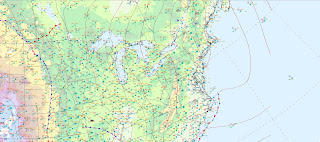Daily
forecast discussion…
The surface chart shows low pressure and the cold front pushing to the east. Today winds are still gusty, with temperatures slightly cooler behind the front, but the temperatures will stay above average for the next 36 to 48 hours.
A little
shortwave near Lake Ontario will push north and east through tonight, bringing
the chance for a few rain and snow showers for Northern New York State and Northern
New England.
Another
system will be approaching on Tuesday, with the mild temperatures, it will
start as rain showers as it moves north and east. Rain will start across
southwest Pennsylvania during Tuesday afternoon. These will work across the
region during the rest of New Years Eve.
General
timing
For the I-95
corridor rain will likely reach Washington DC after midafternoon into the
evening, then maybe clearing out by midnight. Philadelphia will see rain moving
during the evening, it could be moving out just before Midnight. The showers
will move into New York City during the evening likely staying to around
Midnight. For Boston rain will be moving in late evening and thru Midnight. For
most interior areas it will be raining New Years eve, evening into the night. Northern
New York State, northern New England look to see the rain arrive after
midnight.
Rain could
be heavy at times. There will also be the chance for a few thunderstorms. So,
dress for the weather and bring an umbrella.
For many of
us, rain will linger into New Years Day morning, then colder air will start to
move into the region behind the cold front, where it is still raining, will see
rain start to change over to wet snow. Wednesday will remain blustery. For the Middle Atlantic, Pennsylvania,
southern New York State and southern New England, there could be a few
snowflakes, but little to no accumulation. Northern New York State and Northern
New England could see a few inches, this will be especially true for the higher
elevations.
Wednesday
night, as the cold air moves over the Great Lakes; Lake Effect Snow will be
starting to fall downwind of Lake Erie and Lake Ontario. At first winds look to
be Southeast keeping snow on the southwest side of both Lakes, then for Thursday
and into Friday the bands would shift north, before shifting back South Friday
night into Saturday. Lake snows should be winding down on Sunday. Under the
most persistent bands several inches of lake snow will be possible. For the rest of the region for Thursday into
the weekend, winds will be breezy and there will be a chance for snow showers and squalls, this will be especially
true from northern Pennsylvania and points northward.
Sunday should be generally dry away from the lakes, as high pressure starts to build in. The high pressure won’t hang around for long as low pressure will be approaching for Monday. We’re going to see the primary low move into the lower Great Lakes and Saint Lawrence Valley. Then a secondary low will develop off the Coast, as the primary transfers its energy. Too early to go into impacts, but the cold air will be in place, so this has a lot of potential at least for some areas. Could there be a mix/snow in the coastal plain? … Maybe!
This will be my last post until Thursday. So I want to wish all y'all a Happy New Year. The New Year is a blank page waiting to be written. As we enter the New Year, lead with courage and your heart, to write your story and create your dreams!




















































